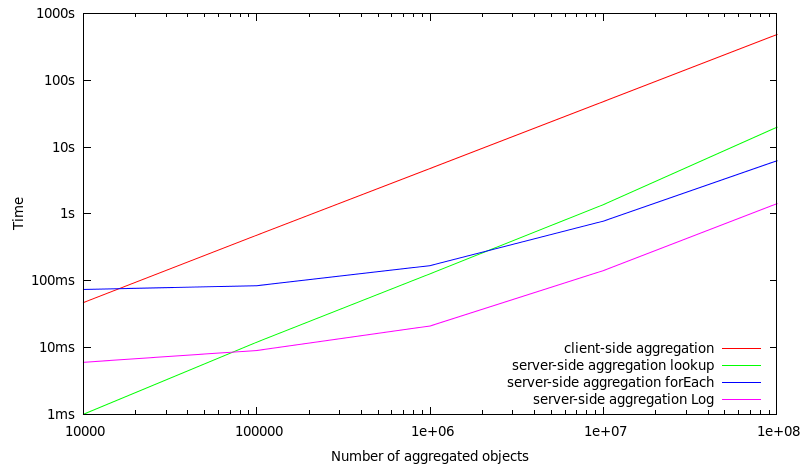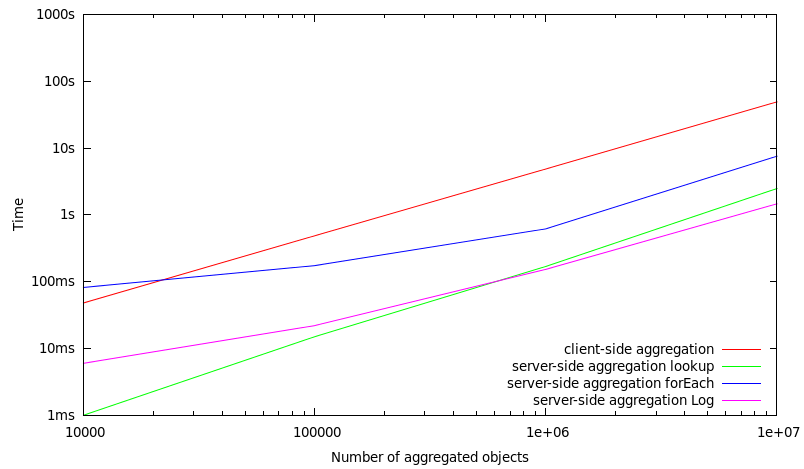Purpose
The intention of this page is to present experiments with non-CRUD data operations.
Aggregation Operation
An aggregation operations adds up the values of a number of objects. When executing such an operation in RAMCloud three questions, among others, are of interest:
- Where to execute the aggregation operation (client or server side)?
- How to describe the range of objects which should be included in the operation?
- How to interpret the objects themselves?
The experiments below are centered around the question about where to execute the operation. Three different scenarios are implemented:
- Client-side aggregation: The client-side aggregation is implemented in a way that a client requests a number of objects one by one where each object contains one integer value. Consequently, a read-RPC gets invoked for every object and the client locally computes the sum.
- Server-side aggregation via hashtable lookup: A range of keys is passed to the server and the server performs a lookup in its own hash table for every object. Again, each object contains a single integer which gets added up (as shown in Listing 1). Once the aggregation is done, the resulting sum is sent back to the server via RPC.
- Server-side aggregation via hashTable forEach: The hash table in the MasterServer offers a forEach method that iterates over all objects contained in the hash table. A callback can be registered to that method which is shown in Listing 2.
- Server-side aggregation via Log traversal: In a MasterServer in RAMCloud, the actual objects are stored in a log. In this experiment, the complete Log is traversed without using the hash table at all (as shown in Listing 3).
for(uint64_t i = 0; i < range; ++i)
{
LogEntryHandle handle = objectMap.lookup(tableId, i);
const Object* obj = handle->userData<Object>();
int *p;
p = (int*) obj->data;
sum += (uint64_t)*p;
}
/**
* Aggregation Callback
*/
void
aggregateCallback(LogEntryHandle handle, uint8_t type,
void *cookie)
{
const Object* obj = handle->userData<Object>();
MasterServer *server = reinterpret_cast<MasterServer*>(cookie);
int *p;
p = (int*) obj->data;
server->sum += (uint64_t)*p;
}
/**
* Aggregation via traversing all SegmentEntries throughout the entire Log
*/
uint64_t
Log::aggregate()
{
uint64_t sum = 0;
//Iterate over all Segments in the Log
foreach (ActiveIdMap::value_type& idSegmentPair, activeIdMap) {
Segment* segment = idSegmentPair.second;
//Iterate over all SegmentEntries in a Segment
for (SegmentIterator i(segment); !i.isDone(); i.next()) {
SegmentEntryHandle seh = i.getHandle();
//Check that it is an Object
if (seh->type()==560620143) {
const Object* obj = seh->userData<Object>();
int *p;
p = (int*) obj->data;
sum += *p;
}
}
}
return sum;
}
Benchmarking
The benchmarks below have been executed using separate machines (out of the Stanford RAMCloud cluster) for client and server which are connected via Infiniband. After each run, the equality of the client-side and server-side calculated sum has been checked. During all runs, the hash table size was set to 5GB.
Benchmarks over all stored objects (low selectivity)
In this set of benchmarks, all objects which are stored in a MasterServer are included in the aggregation operation. Consequently, this means that if 1.000.000 objects are aggregated, there are only 1.000.000 objects stored within a MasterServer.
#number of objects |
client-side aggregation |
server-side aggregation |
server-side aggregation |
server-side aggregation |
|---|---|---|---|---|
10.000 |
47 ms |
1 ms |
74 ms |
6 ms |
100.000 |
480 ms |
12 ms |
84 ms |
9 ms |
1.000.000 |
4790 ms |
127 ms |
168 ms |
21 ms |
10.000.000 |
48127 ms |
1378 ms |
781 ms |
142 ms |
100.000.000 |
485091 ms |
19854 ms |
6245 ms |
1422 ms |
Benchmarks over a subset (10%) of stored objects (high selectivity)
In this set of benchmarks, only a subset of 10% of the objects which are stored in a MasterServer are included in the aggregation operation. Consequently, this means that of 1.000.000 objects are aggregated, there are 10.000.000 objects stored in total within a MasterServer.
#number of objects |
client-side aggregation |
server-side aggregation |
server-side aggregation |
server-side aggregation |
|---|---|---|---|---|
10.000 |
48 ms |
1 ms |
82 ms |
6 ms |
100.000 |
486 ms |
15 ms |
174 ms |
22 ms |
1.000.000 |
4865 ms |
169 ms |
618 ms |
153 ms |
10.000.000 |
49223 ms |
2481 ms |
7565 ms |
1465 ms |
Conclusions
This previous benchmarks allow the following conclusions:
- By executing the aggregation on the server-side a performance improvement up to a factor 100x can be seen if one is using the hash table for the iteration. If one is directly traversing the Log, a performance improvement of up to a factor 450x can be seen (although it is questionable if a Log traversal would be appropriate for executing server-side data operations).
- When traversing a set of distinct objects, retrieving a single object takes about 7-8?s (or a RAMCloud client can request about 130.000 objects/sec from a single RAMCloud server).
- When invoking the hashTable forEach method the whole allocated memory for the hashtable has to be traversed. This is fine if the hashtable is densely packed with objects. In case of a sparse population with objects this introduces a penalty.

